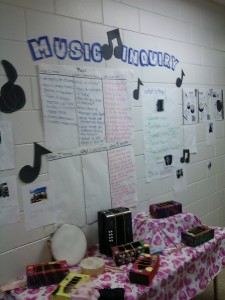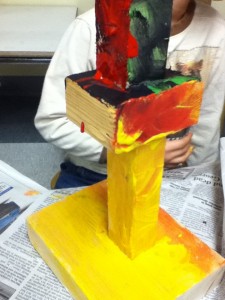
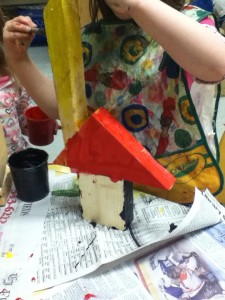
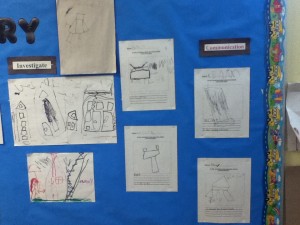
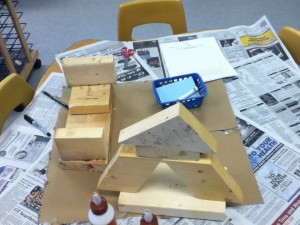
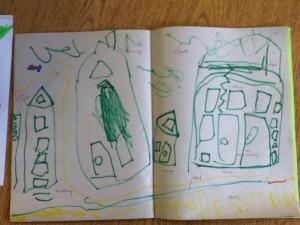 This student independently drew a picture of his neighbourhood when we were writing in our journals. He carefully selected shapes that are parts of a building, told me about the buildings-some stores and houses and added stairs that go to the bed on the top floor (blueprints show stairs!).
This student independently drew a picture of his neighbourhood when we were writing in our journals. He carefully selected shapes that are parts of a building, told me about the buildings-some stores and houses and added stairs that go to the bed on the top floor (blueprints show stairs!).
Keep a clipboard handy for assessment possibly by subject or learning area–mark it as such–create a class list and produce a 3 column chart with these headings-
• Three-column chart (Got It! Getting There! Needs Help) to quickly capture student understanding and next steps for instruction.
I keep something similar to this on hand at all times in a folder. I use the headings Not Evident, Some Evidence, Evident. Or Needs Improvement, Satisfactory, and Good. I also keep a column for comments/next steps and a place on the bottom to write notes.
• Laminated folder with post-it notes to monitor ongoing student progress and development of a skill, strategy and/or technique (i.e., I, L, ?).
• Anecdotal notes, one-on-one conferencing and written observations of student understanding in a variety of settings (whole, small-group, partner activities). I created a table with large blocks and placed each child’s name in one. This way I can keep track of who I have written notes for and have the subject indicated on the top. I also keep extra paper on hand if I see/hear a special oral conversation that needs to be noted.
]]>Main Page that will tell you about the project http://www.mlvpz.org/index.html
Documentation samples http://www.mlvpz.org/documentation/index.html
]]>When we begin working on a new unit of study we need to collect information to see where students are at so we can plan what we need to teach.
Diagnostic Assessment is a ”pre” task that will give you an idea of what students know or not, before you get started. Example:
Teachers can choose the assessment tools they need to collect, organize, and record information about the student learning during the unit. It is also the informal times that we may see learning. So choosing how that will be captured-camera, recorder etc. may be an alternate form of assessment to keep on hand.
Assessment as Learning is the ongoing monitoring of student progress, allowing for feedback, changes/tweaking, and adjustments or whatever is needed to give the students a clear understand of how they can improve. Example: This can be done in small group, with descriptive feedback, conferences, written exchange of dialogue, oral conversations, etc. This may be a time when the teacher needs to provide mini-lessons to fill the gaps in learning to make the students successful.
Here is a link to an article on formative assessment http://earlylearningcentral.ca/wp-content/uploads/2009/02/Research-for-Teachers-Number-2-Formative-Assessment-article-nov-2010.pdf. Formative assessment assists students making them successful by giving suggestions for improving learning rather then just judging.
Summative Assessment is the final task at the end of the unit where students show their final learning. This can take a variety of forms and should allow for students to show their learning from a variety of tasks. Some students may want to choose to illustrate their learning through a visual-drawing, artwork. Some may need to display in an oral conversation, a play etc. Giving students different assessment strategies based on their learning styles and needs, will engage students and give them other options to display their learning.
Here is a full link on ELC around assessment http://earlylearningcentral.ca/?page_id=2234
]]>When creating centres in the primary grades they need to be inviting, allow for multiple students to be engaged, and connect to the curriculum or big idea (purposeful!).
Primarily Play Document provides some great examples of how to start and extend inquiry ideas that can connect to the curriculum expectations as well as some examples of what it could look like in the classroom. http://earlylearningcentral.ca/wp-content/uploads/2009/02/PP-57-59.pdf
http://earlylearningcentral.ca/wp-content/uploads/2011/08/newlookplay.pdf
]]>
In this display, children worked in large group creating a KWL chart, identified some new vocabulary, and had guest speakers come in to show their talents! Each student create an instrument that they were interested in and they are displayed for all to see on the table. The final piece is where each student communicated what new information they learned through the inquiry and how they changed as a researcher. This information will be inserted into their documentation binders.
]]>Focusing on the classroom environment is important in engaging students. It tells them what is valued, what is important in learning and it will certainly set a tone for learning. As I return to my classroom I am reflecting on what has worked and what hasn’t and other ways I can give students opportunities to learn new things.
For example, more computer access to seek information on our inquiry projects, adding mirrors to our light table area, looking at my shelving space and how I can organized various materials to make things more appealing to my students, and creating more centres of inquiry. With all this happening, how can I better assess my students through documentation. I created a new form that my ECE partner and I can track conversations in a more organized fashion and we can simply slip the forms into portfolios as opposed to always typing the information out. I also gathered more clipboards to have at each station and labelled these as our documentation boards.
Here are a few photos of centre idea where children can be creative.
This is a great little centre that focuses around found materials. Students can develop their fine motor skills in connection to math or art. The mats are earth tone in colour and are used as a different surface for children to create.
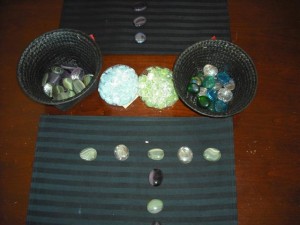 This centre idea uses material found at the dollar store. There are jewels and stones of different colours that you can place in different baskets sorted by colour/shapes/size its up to you. You can use placemats, black felt, photo frames that students can use to display their different art pieces. Again, you can connect to math and a great oral language opportunity for the children.
This centre idea uses material found at the dollar store. There are jewels and stones of different colours that you can place in different baskets sorted by colour/shapes/size its up to you. You can use placemats, black felt, photo frames that students can use to display their different art pieces. Again, you can connect to math and a great oral language opportunity for the children.
Here are some pictures of one environment http://earlylearningcentral.ca/?page_id=2138 to get you thinking about your space. Reflective Questions: What do you do when the environment is not working for your students? How can you place materials that will engage student learning? How can I document student learning and display it?
]]>Another important part that stood out the most for me was the accountability. We are constantly defending the play-based learning approach to parents, the public and what better way to display learning through prompts, pictures, and questioning. Display student work with their dialogue, questioning. Have their portfolios out and accessible for them to refer back to, display learning over time–history from previous years. Create a communication board on inquiry and show students engaged in learning! Have a read and enjoy!
]]>An example of differentiating instruction that was supportive in strengthening skills in literacy was to use visuals. When I chose my read aloud for the week, I ensured that when we discussed “characters”(for example) I had copied pictures either photocopied or in colour, I also included a drama piece when we focused on retelling the story. When it came time to work one-on-one to test comprehension, I often used the pictures of the characters to help them. Another idea that I also used was to photocopy 5 main parts of the story and have the children assemble it in order and orally tell me what they remembered from the story.
In looking at the environment of the classroom, surely posting up student work to display what they have learned makes them feel valued. Posting pictures of the students while completing various tasks, displaying learning charts/anchor charts from the inquiry process with children’s names next to their ideas, and having clear learning goals discussed and displayed in the centres helps guide learning in the classroom. It also displays to parents what the children are learning. The entire classroom environment sets the tone for learning and really shows what is valued and important. In our school we have implemented a program called First Steps. We talk about setting rules for circle time through simple songs, being respectful, and we centre on student strengths. Attached is a great checklist to reflect on your classroom and school environment http://earlylearningcentral.ca/wp-content/uploads/2009/02/R-of-M-grade-1-creating-the-whole-school-learning-environemnt.pdf . Reflecting the culture of your students into the classroom also provides a great learning point. Since most of my students are from an aboriginal background we discuss the medicine wheel and how it ties into nature. I have framed pictures of the students dancing in powwows, books and artifacts are displayed around the room. Reading resources have been easily integrated into my reading program. The use of visuals (pictures, book, artifacts) have been introduced in my oral language groups as a starting point for discussions.
If children have special needs, an IEP is a place where you would need to document specific learning instruction (accommodations) that will best meet the students learning goals. In Kindergarten, it starts with clear goals, visuals, and oral discussion for them to be successful.
]]>Written Observation or Anecdotal records details some critical information about how to collect that information and when it is applicable. Recording the time, date onto the back of work samples provides a context. It also discusses some great points about factors that affect observation records.
On p. 6 of the pdf there is a great chart that gives some ideas on “what you need to find out” and the “tools/strategies” you can use to assess. If you do collect work samples; a binder, a folder or scrapbook is a great way to house the information.
When assessing students it is always important to collect information over time so that you get their best work and really see their full potential. Keep in mind that accommodations may be beneficial for many of your students and as you meet with each child, you can see their unique qualities and change as needed. On p.5 (p.30-31) of the pdf, there are ideas for instructional, environmental, and assessment accommodations.
I encourage you to read the section on Assessment in the Thinking it Through document as it give some great tools and strategies, some “ahas”, and there may be something new that can add a creative twist to assessments!!
]]>
